Sensor Sweep: Time Machine, Clark Ashton Smith, Jack Vance, Into the Unknown
Monday , 20, March 2023 Sensor Sweep Leave a commentRobert E. Howard (Paperback Warrior): “The Frost-Giant’s Daughter” was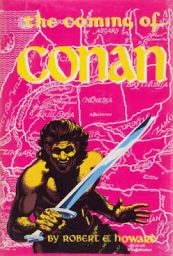 written by Robert E. Howard in the early 1930s. The story, featuring Conan the Cimmerian, was originally rejected by Weird Tales, so Howard changed the character to Amra of Akbitana and called the story “The Gods of the North”. It was accepted and published by The Fantasy Fan #7 in March, 1934. As a Conan story, its original, more popular form, “The Frost-Giant’s Daughter”, was published in The Coming of Conan (Gnome Press, 1953) and Conan of Cimmeria (Lancer, 1969). At just 10 paperback pages, it ranks in the top echelon of Conan literature.
written by Robert E. Howard in the early 1930s. The story, featuring Conan the Cimmerian, was originally rejected by Weird Tales, so Howard changed the character to Amra of Akbitana and called the story “The Gods of the North”. It was accepted and published by The Fantasy Fan #7 in March, 1934. As a Conan story, its original, more popular form, “The Frost-Giant’s Daughter”, was published in The Coming of Conan (Gnome Press, 1953) and Conan of Cimmeria (Lancer, 1969). At just 10 paperback pages, it ranks in the top echelon of Conan literature.
 Firearms (Spec-Ops Magazine): The Heckler & Koch VP9, known as the SFP9 in Europe and Canada, is a semi-automatic striker-fired handgun that has significantly impacted the firearm industry since its launch in 2014. This pistol’s design incorporates several innovative features, such as its customizable grip, ambidextrous controls, and patented charging supports, making it a versatile and reliable firearm that has gained popularity among law enforcement agencies and civilian shooters. This article will examine the VP9, exploring its history, design, and notable features.
Firearms (Spec-Ops Magazine): The Heckler & Koch VP9, known as the SFP9 in Europe and Canada, is a semi-automatic striker-fired handgun that has significantly impacted the firearm industry since its launch in 2014. This pistol’s design incorporates several innovative features, such as its customizable grip, ambidextrous controls, and patented charging supports, making it a versatile and reliable firearm that has gained popularity among law enforcement agencies and civilian shooters. This article will examine the VP9, exploring its history, design, and notable features.
Radio (Tangent): Escape (1947-1954) aired “The Time Machine” on May 9, 1948 as the show’s 40th episode. Not surprisingly, we have aired many episodes (35+) of this top-shelf program over the past 14 years, the last coming in November of 2022. A spinoff and sister show of the highly popular radio program Suspense (1942-62), Escape produced (according to one source) 251 episodes of which 241 were unique stories, plots, or scripts. Escape concentrated on adventure tales, some with an SF/F theme, though the straight adventure tale set in exotic locales was its meat and potatoes.
Weird Fiction (Grognardia): Many adjectives could be ascribed to the pulp fantasies of Clark Ashton Smith, but “heroic” is generally not among them. Yet, for all of its intimations of hidden horror and ancient secrets (to paraphrase H.P. Lovecraft’s own assessment of the story), I cannot help but feel that “The Black Abbot of Puthuum” is a rare example of a largely heroic tale within Smith’s canon.
Science Fiction (Dark Worlds Quarterly): “The Tomb From Beyond” by Carl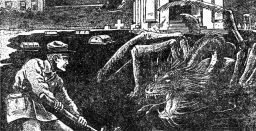 Jacobi is that unusual item, a weird tale in a Science Fiction magazine. Hugo Gernsback published it in Wonder Stories in November 1933. Gernsback had published H. P. Lovecraft earlier, back in his Amazing Stories days, “The Colour Out of Space”, September 1927. He also published a good many Lovecraftian pieces by Clark Ashton Smith until a disagreement over editing. Gernsback lost Lovecraft’s pen over lack of payment. HPL dubbed him “Hugo the Rat”. Despite this, Gernsback liked the Horror/Science Fiction hybrid and used it when he could.
Jacobi is that unusual item, a weird tale in a Science Fiction magazine. Hugo Gernsback published it in Wonder Stories in November 1933. Gernsback had published H. P. Lovecraft earlier, back in his Amazing Stories days, “The Colour Out of Space”, September 1927. He also published a good many Lovecraftian pieces by Clark Ashton Smith until a disagreement over editing. Gernsback lost Lovecraft’s pen over lack of payment. HPL dubbed him “Hugo the Rat”. Despite this, Gernsback liked the Horror/Science Fiction hybrid and used it when he could.
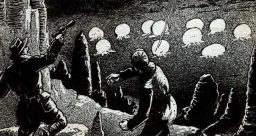 Weird Fiction (Dark Worlds Quarterly): “The Cosmic Horror” by Richard F. Seabright appeared in Hugo Gernsback’s Wonder Stories, August 1933. (Richard F. Seabright was one of Lovecraft’s circle, though he never shone like the more prolific writers like Robert Bloch and August Derleth. He wrote seven stories (mostly for Weird Tales) and eleven poems for the Pulps. I think he thought of himself as a poet primarily.) As the title implies, this is Science Fiction and Horror blended into a tale of a rampaging monster.
Weird Fiction (Dark Worlds Quarterly): “The Cosmic Horror” by Richard F. Seabright appeared in Hugo Gernsback’s Wonder Stories, August 1933. (Richard F. Seabright was one of Lovecraft’s circle, though he never shone like the more prolific writers like Robert Bloch and August Derleth. He wrote seven stories (mostly for Weird Tales) and eleven poems for the Pulps. I think he thought of himself as a poet primarily.) As the title implies, this is Science Fiction and Horror blended into a tale of a rampaging monster.
Robert E. Howard (Silver Key): One of the ways I’ve been mentally gearing up for my trip to Cross Plains is by reading Robert E. Howard’s letters, including a recent purchase of the new vol. 2 from the Robert E. Foundation. These cover the years 1930-32. I want to get into the dude’s mind before I make my way to his hometown. I found these fun, interesting, inspiring, and revealing. If you want to learn who Howard was and how he thought, his letters are a must. A large portion of this collection are long missives to H.P. Lovecraft, with whom Howard began corresponding in 1930.
Science Fiction (Grognardia): A comment to yesterday’s post reminded me of a longstanding mystery: the influence, if any, of the works of Clark Ashton Smith on those of Jack Vance. Purely on the basis of subject matter and style, I’d long assumed that Vance’s tales of The Dying Earth had been influenced by Smith’s own tales of Zothique. I eventually read something – I cannot recall precisely where – that addressed the matter, claiming that Vance had not in fact read Smith and, therefore, any resemblance between the two mordantly witty writers was purely coincidental.
D&D (DM David): The Shadowdark game by Kelsey Dionne of The Arcane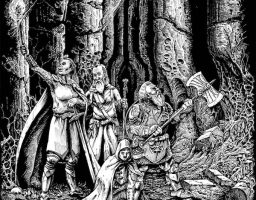 Library bills itself as delivering old school gaming with modernized mechanics. Shadowdark hardly rates as the first game with this approach. Into the Unknown (2019) boasts 5E compatibility combined with old-school mechanisms such as “morale, reaction rolls, random encounters, gold for XP, and henchmen.” Still, with a Kickstarter closing in on a million dollars, Shadowdark stands as an unprecedented success.
Library bills itself as delivering old school gaming with modernized mechanics. Shadowdark hardly rates as the first game with this approach. Into the Unknown (2019) boasts 5E compatibility combined with old-school mechanisms such as “morale, reaction rolls, random encounters, gold for XP, and henchmen.” Still, with a Kickstarter closing in on a million dollars, Shadowdark stands as an unprecedented success.
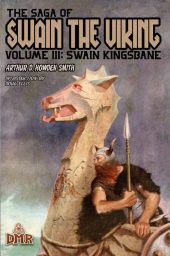 New (DMR Books): Swain the Viking returns once more! DMR Books has already reprinted two volumes of Arthur D. Howden Smith’s critically acclaimed but hard to find historical adventure series, and the third shall appear in early April. In Swain Kingsbane, Swain has thrown his lot in with King Ingi, whose brothers King Sigurd and King Eystein continually intrigue against him. Will Swain be able to end the turmoil and unite all Norway under Ingi? Before one man alone can wear the crown, blood will be spilled, battles will be fought on land and at sea, and Swain will earn the name Kingsbane.
New (DMR Books): Swain the Viking returns once more! DMR Books has already reprinted two volumes of Arthur D. Howden Smith’s critically acclaimed but hard to find historical adventure series, and the third shall appear in early April. In Swain Kingsbane, Swain has thrown his lot in with King Ingi, whose brothers King Sigurd and King Eystein continually intrigue against him. Will Swain be able to end the turmoil and unite all Norway under Ingi? Before one man alone can wear the crown, blood will be spilled, battles will be fought on land and at sea, and Swain will earn the name Kingsbane.
Fantasy (DMR Books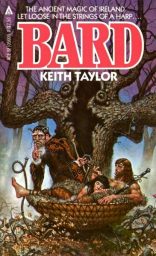 ): Keith Taylor is the author/co-author of 11 novels and dozens of short stories, for fans of the sword-and-sorcery subgenre most notably the Bard series, featuring the wandering Felimid mac Fal and his picaresque adventures in early Dark Ages Britain. Taylor began writing professionally in the mid-1970s with appearances in the likes of Ted White’s Fantastic and the Andrew Offutt edited Swords Against Darkness anthologies.
): Keith Taylor is the author/co-author of 11 novels and dozens of short stories, for fans of the sword-and-sorcery subgenre most notably the Bard series, featuring the wandering Felimid mac Fal and his picaresque adventures in early Dark Ages Britain. Taylor began writing professionally in the mid-1970s with appearances in the likes of Ted White’s Fantastic and the Andrew Offutt edited Swords Against Darkness anthologies.
Cinema (American Greatness): “Cattle Queen of Montana” tells the story of Sierra Nevada Jones (Barbara Stanwyck) who along with her father leaves Texas for Montana. As a family, they have inherited a large portion of the land, and they wish to continue to raise cattle. Sierra ends up fighting both the Indians and Tom McCord, a local man who uses the violent faction of the Indian tribe in order to steal the land from Sierra.
Edgar Rice Burroughs (ERBzine): Tarzan had been betrayed. Drugged and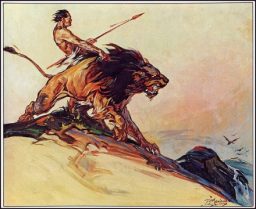 helpless, he was delivered into the hands of the dreadful priests of Opar, last bastion of ancient Atlantis. La, High Priestess of the Flaming God, had saved him once again, driven by her hopeless love for the ape-man. But now she was betrayed and threatened by her people. To save her, Tarzan fled with her into the legendary Valley of Diamonds, while Jad-bal-ja, his faithful golden lion, followed. Ahead lay a land where savage gorillas ruled over servile men. And behind, Estaban Miranda—who looked exactly like Tarzan—plotted further treachery.
helpless, he was delivered into the hands of the dreadful priests of Opar, last bastion of ancient Atlantis. La, High Priestess of the Flaming God, had saved him once again, driven by her hopeless love for the ape-man. But now she was betrayed and threatened by her people. To save her, Tarzan fled with her into the legendary Valley of Diamonds, while Jad-bal-ja, his faithful golden lion, followed. Ahead lay a land where savage gorillas ruled over servile men. And behind, Estaban Miranda—who looked exactly like Tarzan—plotted further treachery.
Culture (Wasteland & Sky): The worst thing that ever happened to the hobby of reading was mystifying it and turning a simple pastime into a personality trait for hipster types and loners. This has not led to anything good. The process of transforming something anyone can (and should) do into an identity for antisocial people has transformed the entire industry into an ongoing war against general customers and the Average Joe.
Tolkien (Goodman Games): J.R.R. Tolkien’s The Lord of the Rings was the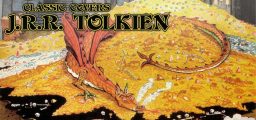 book that launched a thousand trilogies, and made Tolkien’s name synonymous not just with modern fantasy fiction, but publishing mega-success. With more copies, in more languages, in more editions, than anything else in its category, and with an entire sub-industry spun out of publishing various notes, unpublished drafts, and side-excursions of its author, The Lord of the Rings remains the gold standard by which all other secondary worlds, and all other fantasy blockbusters, are judged. With covers ranging from the iconic to the iconographic, the literal to the surreal, many even featuring the art of the good Professor himself.
book that launched a thousand trilogies, and made Tolkien’s name synonymous not just with modern fantasy fiction, but publishing mega-success. With more copies, in more languages, in more editions, than anything else in its category, and with an entire sub-industry spun out of publishing various notes, unpublished drafts, and side-excursions of its author, The Lord of the Rings remains the gold standard by which all other secondary worlds, and all other fantasy blockbusters, are judged. With covers ranging from the iconic to the iconographic, the literal to the surreal, many even featuring the art of the good Professor himself.
Lovecraft (DVS Press): Despite being called the father of horror, very few modern authors imitate H.P. Lovecraft. When they do, they tend to steal elements of his “world-building,” that is, they use the Cthulu Mythos or other elements of the stories and write in a totally different style from Lovecraft. This tends to miss what makes Lovecraft’s work compelling; it’s not the mythos itself, but how it is revealed that makes such an impact. Lovecraft is really Weird Fiction, not so much “Horror,” which as a literary genre solidified itself later in the 20th century.
Art (DMR Books): Back in January, during this year’s Guest Bloggerama,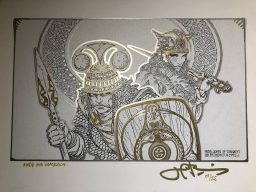 Stan Wagenaar reviewed Keith Taylor’s ‘Danans’ series of heroic fantasy novels. Stan did a great job of providing an overview of those neglected books, which can be found here. The only downside to the review, in my opinion, was that even the best cover from the series, The Cauldron of Plenty, was just okay. Rendered in the realistic style favored since about 1980 by art directors, Dean Morrissey’s cover—like his other two Danans covers—was static, obviously painted from a model and did nothing to invite the potential reader to check out the wonder and adventure which lay within.
Stan Wagenaar reviewed Keith Taylor’s ‘Danans’ series of heroic fantasy novels. Stan did a great job of providing an overview of those neglected books, which can be found here. The only downside to the review, in my opinion, was that even the best cover from the series, The Cauldron of Plenty, was just okay. Rendered in the realistic style favored since about 1980 by art directors, Dean Morrissey’s cover—like his other two Danans covers—was static, obviously painted from a model and did nothing to invite the potential reader to check out the wonder and adventure which lay within.
RPG (Trilemma): Now that the core of Dungeons & Dragons has been effectively open sourced, a lot of retro-clone designers are breathing a sigh of relief. You can’t copyright mechanics, but that hasn’t stopped numerous lawsuits in the past. Those days seem to be over!
I thought it might be nice to look at some of those now-free core mechanics that have been with the game since its very early, dungeon-centric editions.
Cinema (Kairos): Frequent readers may have noticed that my current workload has compelled me to keep recent posts on the shorter side. But I thought you good folks deserved some red meat. So I’ve made time to review the neo-noir stylistic sensation John Wick. I revisited this series recently. And with nigh on a decade between the first film’s release and this writing – though it seems longer – the trilogy seemed ripe for a fresh appraisal.
workload has compelled me to keep recent posts on the shorter side. But I thought you good folks deserved some red meat. So I’ve made time to review the neo-noir stylistic sensation John Wick. I revisited this series recently. And with nigh on a decade between the first film’s release and this writing – though it seems longer – the trilogy seemed ripe for a fresh appraisal.
Tolkien (Tentaclii): My book The Cracks of Doom: Untold Tales in Middle-earth is now available in its expanded third edition. Notes for The Hobbit have been added, as well as many new and expanded additions for The Lord of the Rings. As such the book is now at 28,000 words. It has also had a further two passes of proof-reading, plus Amazon’s own spell-checking (it picked up four I didn’t catch, but Amazon doesn’t know about huorns).
D&D (Goodman Games): We recently previewed a stretch goal from the DCC #100: The Music of the Spheres is Chaos Kickstarter — a hot-off-the-presses door poster of every DCC cover, ever! Well, not quite ever, as it left off the variant covers, but our Poster of 100 Covers (total 126 covers!) already fills up a standard-sized door, so we didn’t think we should squeeze any more on just yet!
#100: The Music of the Spheres is Chaos Kickstarter — a hot-off-the-presses door poster of every DCC cover, ever! Well, not quite ever, as it left off the variant covers, but our Poster of 100 Covers (total 126 covers!) already fills up a standard-sized door, so we didn’t think we should squeeze any more on just yet!
Warhammer (Tenkars Tavern): My return to the world of playing RPGs after a decade’s absence was via Dark Heresy and Fantasy Grounds. I saw a Dark Heresy Game posted on the Fantasy Grounds Forums looking for players and I jumped at it, and then I bought the rulebook 😉
The game lasted a few months and it cemented my return to RPGs and was soon followed by a short Warhammer FRP campaign and a longer Castles & Crusades campaign. The rest, as they say, is history.
Science Fiction (Por Por Books): ‘Deathworld’ first was published as a serial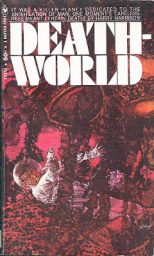 in Astounding Science Fiction in 1960, with a paperback compilation issued by Bantam later that year. This particular Bantam paperback edition (154 pp.) was published by Bantam in 1969, and features cover art by Jim Sharpe.
in Astounding Science Fiction in 1960, with a paperback compilation issued by Bantam later that year. This particular Bantam paperback edition (154 pp.) was published by Bantam in 1969, and features cover art by Jim Sharpe.
Science Fiction (The Obelisk): Spend enough time reading science fiction, and readers will come across the idea of the Big Three of classic science fiction. The current consensus is that Isaac Asimov, Arthur C. Clarke, and Robert Heinlein represent the Big Three of science fiction. Except for those who prefer the acrostic list of Asimov, Ray Bradbury, and Clarke as the ABCs of science fiction.
Fiction (Vintage Pop Fictions): Sabre-Tooth, published in 1966, is the second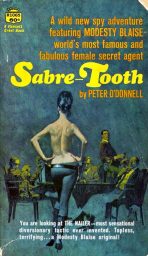 of Peter O’Donnell’s Modesty Blaise novels. Modesty Blaise started out as a comic strip created by O’Donnell in 1963. Its immense popularity led to the making of the Modesty Blaise movie which was released in 1966. O’Donnell was hired to write the screenplay. The producers didn’t like his screenplay and made so many drastic changes that the movie bore little resemblance to O’Donnell’s script and the character in the film bore little resemblance to O’Donnell’s creation.
of Peter O’Donnell’s Modesty Blaise novels. Modesty Blaise started out as a comic strip created by O’Donnell in 1963. Its immense popularity led to the making of the Modesty Blaise movie which was released in 1966. O’Donnell was hired to write the screenplay. The producers didn’t like his screenplay and made so many drastic changes that the movie bore little resemblance to O’Donnell’s script and the character in the film bore little resemblance to O’Donnell’s creation.
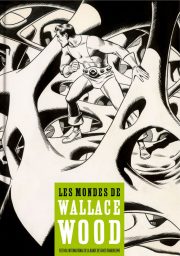 Art (Aeindex): A pioneer of American genre comics, Wallace Wood (1927-1981) was a virtuoso and visionary author. He left a deep mark on science fiction, fantasy, humour and erotic comics throughout a rich and unclassifiable career, to which the Festival is dedicating a rare retrospective. Reproducing more than 150 pieces from the pioneer of American genre comics, this catalogue traces the career and the multifaceted work of a virtuoso author who never ceased to evolve and reinvent himself.
Art (Aeindex): A pioneer of American genre comics, Wallace Wood (1927-1981) was a virtuoso and visionary author. He left a deep mark on science fiction, fantasy, humour and erotic comics throughout a rich and unclassifiable career, to which the Festival is dedicating a rare retrospective. Reproducing more than 150 pieces from the pioneer of American genre comics, this catalogue traces the career and the multifaceted work of a virtuoso author who never ceased to evolve and reinvent himself.
Horror (Bloody Spicy Books): It was love at first sight when I first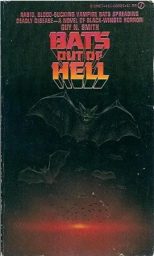 discovered the work of Guy N. Smith. Gruesome deaths, pulp characters, giant monsters and all other sorts of horror tropes flowing from the pen of one man who knew what I liked in a horror novel: a short bloody page count. He’s a man who wrote the book versions of the B-Movies of my teenage (and all years after) years, horror without pretension.
discovered the work of Guy N. Smith. Gruesome deaths, pulp characters, giant monsters and all other sorts of horror tropes flowing from the pen of one man who knew what I liked in a horror novel: a short bloody page count. He’s a man who wrote the book versions of the B-Movies of my teenage (and all years after) years, horror without pretension.
RPG (Captcorajus): RPG Review of Barbarians of Lemuia I promised. This is an outstanding pulp fantasy RPG! Check it out!
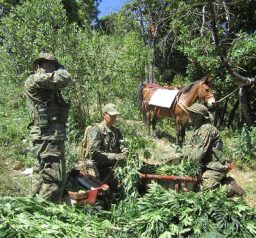 Outdoor (Frontier Partisans): Game Wardens have a history that dates back to the Middle Ages. They are related to Rangers of the American Frontier and other forest warriors. As such they may be seen as forerunners of modern to special operation units. Modern spec ops, however, has also influence on modern game wardens as shown in John Nores book Hidden Wars: How Special Op Game Wardens are Reclaiming American’s Wildlands from the Drug Cartels.
Outdoor (Frontier Partisans): Game Wardens have a history that dates back to the Middle Ages. They are related to Rangers of the American Frontier and other forest warriors. As such they may be seen as forerunners of modern to special operation units. Modern spec ops, however, has also influence on modern game wardens as shown in John Nores book Hidden Wars: How Special Op Game Wardens are Reclaiming American’s Wildlands from the Drug Cartels.
Please give us your valuable comment